The Outlaw Soundboards
Never-heard soundboard tapes from Bob Dylan's Summer 2025 Outlaw tour
Flagging Down the Double E’s is an email newsletter exploring Bob Dylan performances throughout history. Some installments are free, some are for paid subscribers only. Sign up here:
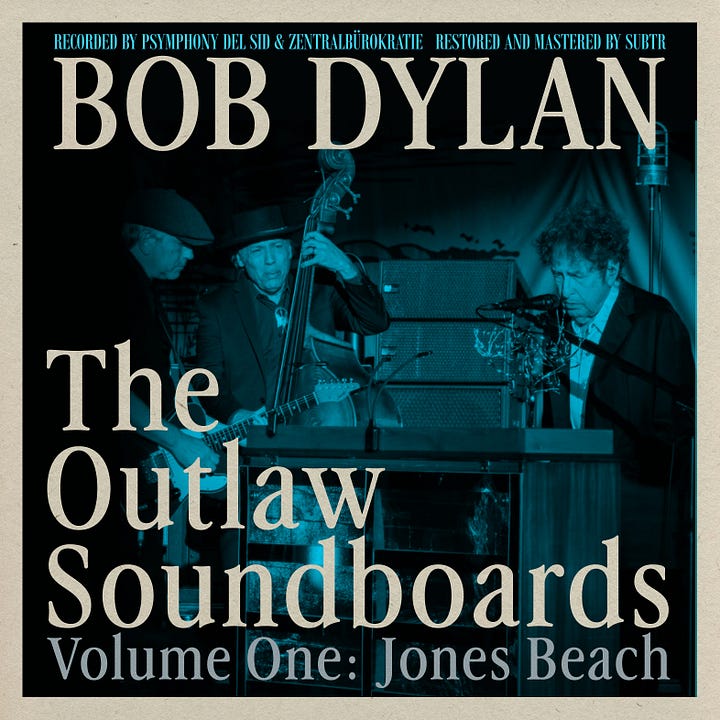

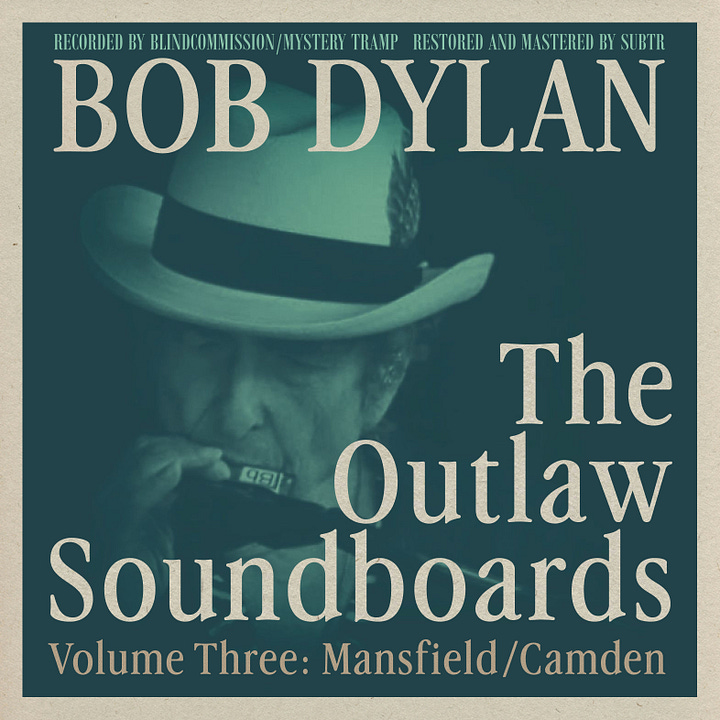
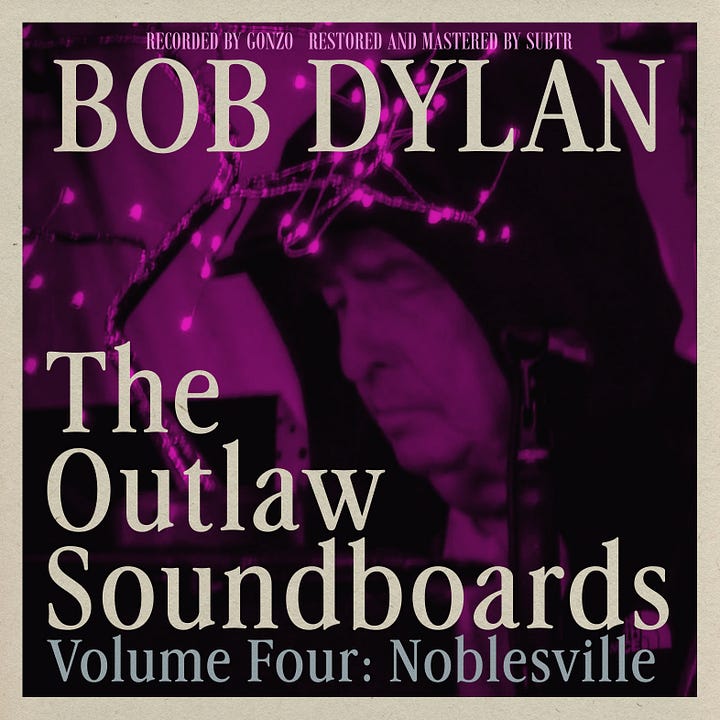
In the 21st century, Bob Dylan soundboards have become a rare thing. The last one of a complete show I believe came in 2009, at the Rothbury music festival. Today, though, 16 years later, we suddenly have three more, all from this summer’s Outlaw tour: Jones Beach, Buffalo, and Noblesville, plus incomplete portions of two additional shows, Mansfield and Camden.
How did this come to be? We’re going to have to get in the technical weeds a bit.
Some of these large outdoor venues have a phone app for so-called ALD feeds. ALD stands for “assisted listening device,” and what this app does is broadcast the front-of-house soundboard feed to one’s phone. Some intrepid fans figured out a way to capture that. Voila, they would have a perfect soundboard recording on their phones.
That was the idea, at least…
The reality turned out to be a lot more complicated. Half the time it didn’t work for one reason or another—a bad wifi signal, the app broadcasting static, etc. The person who organized this endeavor told me quite a few attempts failed.
The other half the time a soundboard-ish recording did get captured, but with two major audio problems:
Tons of dropouts. Tiny gaps every few seconds. The recording ended up sounding like a record skipping—just a little each time, but over and over again, the entire show.
Speed fluctuations. Sometimes the broadcasted audio slowed down, then suddenly overcorrected, sprinting as if to catch up.
One such ALD capture surfaced this summer, from Dylan’s August show in Buffalo. If you listened to it, you heard both of those problems. The sound quality was mostly stunning, but the dropouts and speed changes were distracting. Several ace remasterers cleaned it up, but there was only so much that could be done. It was like 90% of the way to being a perfect soundboard—why couldn’t we get the other 10%?
Turns out we could. A team of people has been working behind the scenes for weeks to get this and several other never-heard-before ALD captures fixed. They shared them with me in advance for publication today.
The key trick was having multiple captures of the ALD app. Every full show below, Buffalo included, is taken from two separate captures, using two separate devices. When one recording dropped out or had a speed issue, even for just a millisecond, the other could be swapped in. They ended up with eight total recordings—two each for shows in Jones Beach, Buffalo, and Noblesville, plus one partial each for Mansfield and Camden. Huge credit to all the tapers, who go by Psymphony Del Sid, Zentralbürokratie, fishcane, Moosejah, BlindCommission, Mystery Tramp, and gonzo. Capturing these took a lot more work than just pressing a button on their phone, and they deserve all our thanks.
After the shows were captured, it took weeks of work by an ace mastering engineer who goes by subtr to whip these raw recordings into shape. The dropouts, which seemed more distracting to me on first listen, were actually more straightforward to fix, subtr reports; they just took an enormous amount of time to do manually. The speed fluctuations were harder to correct. subtr estimates they spent 70 hours working on Jones Beach alone! On one extreme example, the final audio switches back and forth between the two recordings almost every word! (You can read more from engineer subtr at the bottom.)
Okay, that’s enough with the technical details for now—let’s get to the music!
I’ve written plenty, as have many others, about how terrific Dylan sounded this summer. And now you can hear every nuance. You can and should listen to all the tapes, but, since it is a lot, I figured I’d pull a few highlights.
One area where these soundboards particularly shine is the quieter songs. Audience tapes often fall prey to the chatty Outlaw crowds drowning out the music. But this summer Dylan often played quietly despite the loud crowds, and it’s powerful hearing every nuance of, say, show-closer “Don’t Think Twice It’s All Right.” Here’s the version from Noblesville (Tony’s bowed bass sounds great):
Or my favorite song of the summer, “Til I Fell in Love with You.” So powerful every time, the band making skronky background noises, almost like ambient jazz, while Bob sings his ass off overtop. He hadn’t played this live since 2015, but it was worth the wait! Here’s the Jones Beach version:
I also love hearing the echo he was using on several songs. “Masters of War” and “Forgetful Heart” both have his vocals echoing. The latter was another of my favorite arrangements, with those slicing guitars. Here’s the Mansfield version:
Those are three quieter songs, but the louder songs punch through too. Here are two of my favorites from these tapes, “All Along the Watchtower” (that wonderful Van Morrison arrangement, with great acoustic guitar accents from Doug Lancio) from Noblesville and “I Can Tell” in Buffalo (you can actually hear Bob Britt’s backing vocals for once!):
Thankfully, while the setlists mostly remained static, there was some variation across these shows. Four songs we only get one copy of: “Gotta Serve Somebody,” “Positively 4th Street,” “Searching for a Soldier’s Grave,” and “Soon After Midnight.” Check out this funky, disco-fied “Gotta Serve Somebody” at Jones Beach. This was the last time it was performed to open the show. Anton Fig’s drums sound great on this, even if Bob swallows the occasional word.
Hearing Bob’s vocals so clearly, you catch his little asides, the lines Bob adds, often under his breath, like he’s thinking about and responding to the lyrics in real time. They might be indecipherable on an audience tape, or even in the room, but you can catch them here. Here are short clips of three I dug. The first one is the best.
“Under the Red Sky” Jones Beach (“What kinda pie? Cherry pie.”)
“I’ll Make It All Up to You” Noblesville (“I know it”)
“Til I Fell in Love with You” Noblesville (“I wish I hadn’t”)
I jotted down like 30 highlights listening to these tapes, but if I don’t stop I’ll just be embedding every track (well, except one) and saying “This one’s a highlight too!” They all sound that good. So briefly, some other personal favorites not to miss when you listen to these tapes are “To Ramona” and “Blind Willie McTell” from Jones Beach, “Under the Red Sky” and “Positively 4th Street” from Buffalo, “I Can Tell” from Mansfield (love this song every time), “Masters of War” from Camden, and “All Along the Watchtower” and “Highway 61 Revisited” (you can actually hear the guest organ player!) from Noblesville.
Download all four Outlaw Soundboards in lossless FLAC format below. They each have info files with more information about the tapes.
DOWNLOAD THE TAPES
2025-08-01 Northwell at Jones Beach Theater, Wantaugh, NY
Recording #1: Psymphony Del Sid
Recording #2: Zentralbürokratie
Restored and mastered by subtr
2025-08-08, Darien Lake Amphitheater, Buffalo, NY
Recording #1: Fishcane
Recording #2: Moosejah
Restored and mastered by subtr
2025-09-07, Xfinity Center, Mansfield, MA & 2025-09-12, Freedom Mortgage Pavilion, Camden, NJ [both incomplete]
Mansfield recording: BlindCommission
Camden recording: Mystery Tramp
Restored and mastered by subtr
2025-09-18, Ruoff Music Center, Noblesville, IN
Recordings #1 & #2: gonzo
Restored and mastered by subtr
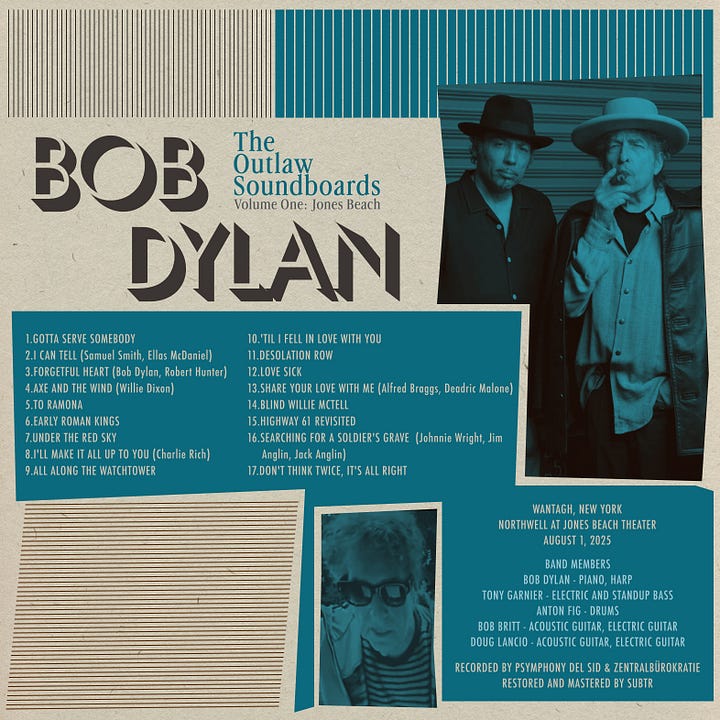
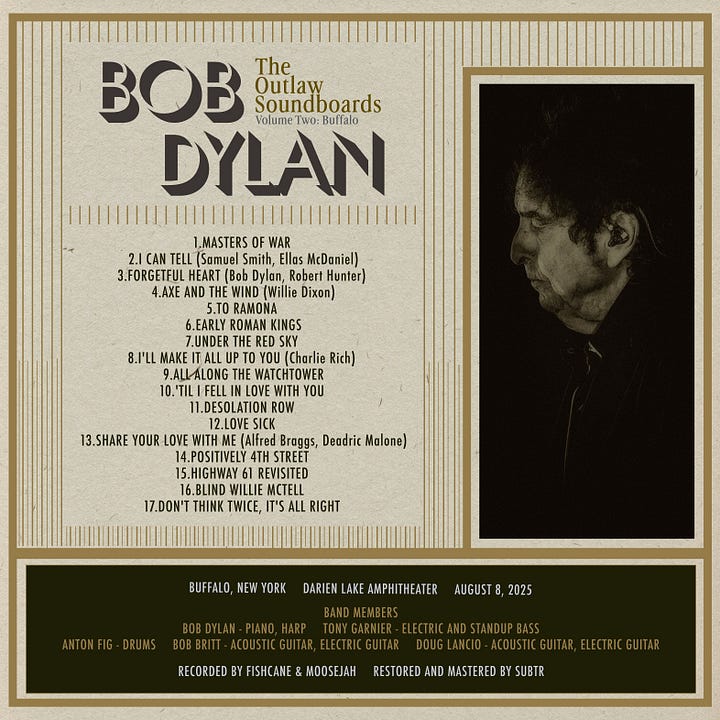


Bonus: For those who want more info on what exactly had to be done to get these raw captures ready for prime-time, subtr answered a few of my questions:
In broad strokes, what needed to be done to fix these?
While the ALD was a mono feed, a couple of sources had issues with one channel being very quiet static, or having one channel louder than the other, so I converted everything to mono initially to keep it consistent, or just used the ‘best’ channel, and level matched sources.
The three full shows had multiple sources and each source was littered with its own issues but many were shared across all, as well as most present in the shorter show excerpts. In short: two types of gaps, clicks/pops, speed issues and occasional stuttering artifacts.
Buffalo had a couple of different sources. and some gaps were in the same place, some slightly different, so stuff could be patched. The same for Jones Beach (2 sources to switch between). Noblesville had some terrible hum on the original. I imagine the quality of the internet stream in the outdoor venues is largely to blame for most of these, possibly the devices used to capture. Some of the gaps were tiny, of a couple of thousands of a second, up to almost half a second, but they were all audible.
There were, I discovered, two types of dropouts too, and each had to be treated differently. One seemed more due to buffering: there was no sound lost, the gap could be cut out and if you ran into a handful of these gaps in a row, removing them would give you the full audio. Although you’d often have to do some tiny cross fades to avoid introducing new artifacts. These were the more ideal of the two.
The other type was where a gap was simply lost audio. For those, I was crossfading between sources after de-gapping both to whatever extent I could, and trying to match the speed between each source. “Desolation Row” on Jones Beach has several verses where it switches between sources almost a word-at-a-time for patches that had bad gaps or stubborn clicks, to keep as much of the original audio as possible. I think it was the ‘worst’ to do - seventy or eighty edit points for one song switching back and forth between the sources. That said, Buffalo was a challenge too, as others have already found - I think it’s the only one to get out there prior to these and hopefully this is the most ‘corrected’ version so far. I’m writing this before I speed correct Buffalo though, a task I do not look forward to.
So, gap removal of one form or another. There were plenty of clicks all over the place too which I also attribute to the stream. They had to go. I did try some automatic declicking but even the mildest settings shaved off a bit of the snap on the snare too much for my liking, so each show was gone through manually.
Next came speed correction. This was clearly another issue caused by the stream. Some sources had moments of slowing down, followed by rapid speeding up until normal speed was resumed. Some of that was dealt with before blending the two sources, or if both had gaps that preserved the full audio, I could select the most consistent for long stretches. I kept notes on timings and then once the sources were compiled I went back in and speed corrected/matched those sections.
After that was the final stage of tweaking the sound as best I could to get away from the boxy, tinny tone of the raw captures. I am usually pretty conservative and try and use EQ only, and bring out the best - it’s all subjective of course - but essentially use what’s there. With these, there was some corrective EQ, some light compression, more EQ, and a little more compression, then some multiband compression, a little more much broader EQ after that and finally a limiter. Oh, and on Noblesville, some hum reduction. There was this cable hum going through a lot of it and some of it’s still there; that was done prior to the work on the sound itself.
What is this in succinct terms?
Getting the best channels of all sources to mono and level matching
Removing thousands of micro gaps in all sources
Crossfading between sources where multiple existed to initially overcome larger gaps or if possible any speed fluctuations
Manual declicking on the resultant blended files
Any noise reduction needed
Speed correction
EQ and compression adjustments to enhance the sound
The main two problems are the tiny dropouts and the speed fluctuations, right? Which is harder to fix?
I think the speed fluctuations are harder. I used some audience recordings to line things up, but there were moments where a cluster of three or four beats rapidly speeds up, then slows down, and then the next 20 seconds was not quite at the speed it should have been but was consistent within itself. Even then, because the audience recordings are captured from farther away from the stage or speakers, getting absolute precision with lining up transients like drum hits isn’t totally possible because the snap of the snare is dulled by travelling 200 metres through the air to the mic on the recording device. Things were a compromise between accuracy and what sounded ‘right’. All of this was a giant ball ache.
The dropouts weren’t too difficult, just fiddly and extraordinarily time-consuming. And there were hundreds of them. I guess over all the shows, several thousand. So they provided a good bit of psychological frustration but were for the most part objectively easy to do, just repetitive in a way that did not encourage a zen-line state of being. Quite the opposite. I had an amazing assistant help me out considerably with gap removal for a couple of the shows and would have probably lost my mind if not for them.
How many hours total did you spend on say Jones Beach, the first one?
Jones Beach was the first show I tackled and had the most issues. I was fresh and keen and dove right in, not quite realising the workload! Thankfully there were two sources, so only the smallest chunk of “Love Sick” and a note from “Soldier’s Grave” is missing (although there is one moment of time-stretching to keep things in rhythm that only kind of works, but there was little other option available to me), but it had everything mentioned above going on in abundance. I spent a couple of hours a night for two weeks getting the gaps out and sources blended. I think in total we’re looking at about 70 hours now.
The other shows didn’t take so long thanks to my assistant tackling the gaps on each source, and both of us realising this was a mammoth task, but each of us kept finding omissions in the other’s work for a while - there were so many of these things! Camden was a dream by comparison: short, basically consistent speed, a fairly clean recording to begin with.
What’s the difference between the “restored” and the “mastered” versions?
The restored versions are the ALD captures with the gaps removed and the clicks gone and the best source for any given moment used. I’m sure a couple of clicks still made it through as, on occasion, I found myself removing one for the mastered files and it’s left on the restored but broadly speaking, “restored” refers to the capture as close as we could get it to what the original stream in the venue that night should have been. Minimal dropouts, clicks, pops and so on.
One thing the “restored” versions don’t correct is the speed, though. Those fluctuations weren’t only annoying, but I’m no master at fixing them and I’m sure in the future someone can do better or some software will come along that can deal with that better than I can. Or someone can dedicate a lot more time to it as a discrete task. In combination with everything else it was just a bit much. But still, they’re pretty clean recordings compared to the handful of multiple sources we started with.
“Mastered” refers to the versions that I’ve then done the speed correction work on and tried to improve the sound on. In general, I think they have more life, presence, and are more pleasing on the ears.
[Note: The organizer will released the “restored” versions in two weeks on Expecting Rain]
Any favorite moments/performances from the tapes?
“Til I Fell In Love With You” on Jones Beach. I cannot get enough of it. On the face of it, it doesn’t seem like anything remarkable but I love the looseness of the band around Dylan, and how that little choppy guitar chord takes up after every other line in the second half and helps the song build; I think Dylan’s in ‘preacher’ mode on it and gives a different kind of performance to a traditionally ‘sung’ song. The guitar work gives me a similar feeling to a moment in the studio take of “Crossing the Rubicon,” where the playing seems like nothing remarkable but to me is so perfect in its interplay with the vocal - about 5:20 to 5:25, the ‘oh Lord’ aside, bookended by each guitar repeating the same riff. When things like that gel and feel so effortless, it’s pure magic. On later dates, he tightens it up as an arrangement and it loses some charm for me, and edges its way towards an old “Cold Irons Bound” arrangement.
Otherwise, “Positively 4th St.” is lovely from Buffalo. “Share Your Love With Me” on Jones Beach. “Highway 61” from Noblesville has a solid mood going on but doesn’t quite nail it. I like what they’re aiming for though. The covers are all pretty good, a lot of fun and in their way a nice route into the new Bootleg Series with Dylan’s early love for rock’n’roll. In general, I think the addition of Anton Fig has pushed this round of Outlaw shows up in quality. I love Keltner, but I’m not sure he was as ‘on’ as he could have been the last couple of years.
Lastly... if anyone does have any restoration, mixing or mastering to be done, I’m available for work! ;)

Great work on producing these soundboards, subtr, and huge thanks for sharing them with us, Ray. The performances sound great! This project raises all sorts of interesting issues about interventions in the recording process.
There was a kerfuffle a while back over the use of autotune on Dylan's duet with Barbra Streisand. Some listeners objected to the removal of seeming imperfections in Dylan's voice, which sanitized out an essential element that we love about his sound. In this case, subtr has sanitized out the crowd chatter, which is the thing we grumble about most as a distraction from Dylan's Outlaw shows.
Since subtr allows us to hear Dylan's voice so much more clearly, I'm all in favor of this novel soundboard project. Bring it on--more please! But it is worth noting that, in both autotune and ALD, what we are hearing is essentially a performance that never happened as such. Dylan didn't hit those pitch-perfect notes while singing with Babs, and he didn't deliver those Outlaw shows in an empty room where the only sounds came from him and the band. Both recordings present alternate realities. They're wish-fulfillment fantasies: just different wishes, different fantasies.
Wow, this is a treat. Thanks for highlighting and publicizing this work, as well as your interview with subtr! As a rank amateur in the bootleg world, this is absolute catnip to me. We're so blessed!